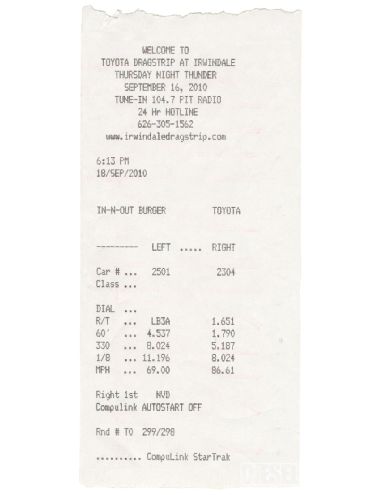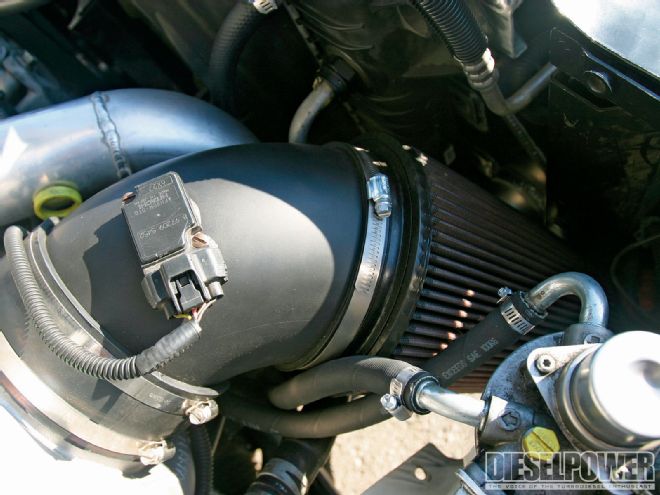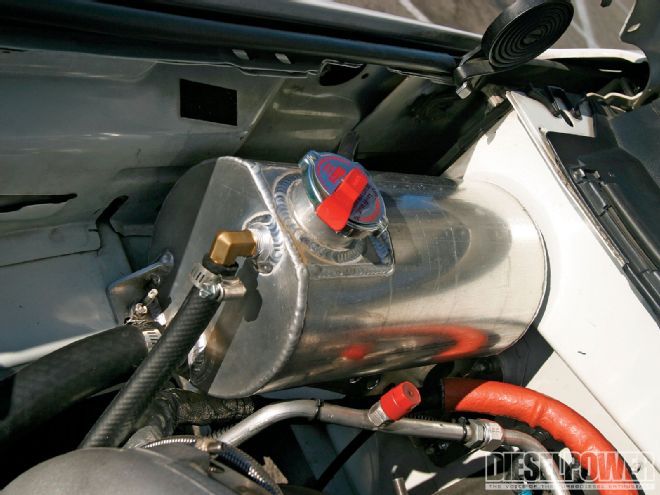For our second installment of the SleeperMax saga, we looked to install a set of twin turbos on Joe Komaromi's '06 LBZ. With a single Garrett GT3788R turbo and a light sprinkling of other modifications, we'd already hit 576 hp on Joe's Mustang II load dyno and run 8.31 seconds at 83.4 mph in the eighth-mile. Although our EGT wasn't sky-high during our dyno runs (1,300 degrees at peak power and 1,500 degrees by the end of the run), we decided to go with a set of Towing Twins to bring EGT completely back to the safe zone. Even though the single turbo cleaned up all the smoke with the PPE Hot+2 E.T. set on Level 5, we figured more boost would still equate to faster track times-especially since both of the turbos would be right in their efficiency range, and boost would be limited to 50 psi as to not overwhelm the stock intercooler.

| 1101dp The Sleepermax 2006 Gmc Sierra 2500hd front Three Quarter Shot Hood Open
Towing Twins
Let's be honest. With a suggested retail of about $8,000, PPE's Towing Twins setup is not a budget turbo kit. But it is a very versatile and well-engineered setup, with dual ball-bearing water-cooled turbochargers, heavily reinforced mounting positions, wastegates, and strengthened up-pipes. Spooling is unbelievably quick due to the ball-bearing design. In fact, not only was there no smoke during our dragstrip runs-there was no smoke while spooling, either. The ball-bearing turbos also use less oil than conventional chargers, so no additional strain is placed on the vehicle's oiling system. We can honestly say these Towing Twins are just about everything you would want in a turbo system.

| PPE's Towing Twin kit is an all-inclusive setup that includes twin ball-bearing turbos as well as all the intake and exhaust piping.
Irwindale Speedway
With Associate Editor Jason Sands behind the wheel, our first run was a weak 8.44 seconds at 85.3 mph. The difference was in the launch, as a 2.0-second 60-foot time was significantly slower than the 1.84 we cut last time. On run number two, the boost was upped to 12 psi on the launch, and the result was a 1.79-second 60-foot time, and an eighth-mile time of 8.02 seconds at 86.6 mph. Even with no smoke, adding the twins and increasing boost from 30 psi to 52 psi had given us a three tenths, 3-mph gain in the eighth-mile, which equates to nearly half a second in the quarter-mile. The truck was definitely making more power, and we couldn't wait to see what it did on the dyno.
On the Rollers
Since the twins went down the track smoke-free, our only dyno test was with the PPE Xcelerator on Level 5-the highest level we could install in the computer without dropping fuel rail pressure. Our previous testing on Level 5 with the single turbo had yielded 576 rear-wheel horsepower and 1,068 lb-ft of torque. EGT was 1,300 degrees at peak power, and 1,500 degrees by the end of the run. We figured the added airflow from the twin turbos would make more power while dropping EGT considerably, and they did just that-although the horsepower gains weren't at all what we expected. After the rollers stopped, the truck had made 587 hp and 1,102 lb-ft of torque-a gain of 11 hp and 34 lb-ft. This was far less than we expected after our dragstrip runs, which indicated a power gain of 50 to 70 hp. The drop in EGT, on the other hand, was astounding, as we couldn't get the truck to break 1,200 degrees if we tried, even on a loaded, 30-second dyno pull.

| The larger of the two Garrett turbos is a GT45, which can suck in enough air to support up to 1,000 crankshaft horsepower.
What We Learned
At this level in the build, we proved a couple of interesting points. With the twins, the truck acted faster than it actually showed in the dyno results, and the answer was in the area under the power curve. The GMC was making 40 psi as low as 2,400 rpm, which meant the truck was at, or near its peak power the entire way down the track, which greatly improved its dragstrip times. We also proved that twins do a ridiculously good job of keeping EGT levels down. We truly feel this is a truck that anyone could just hop in and drive, without worrying about reliability, EGT, or boost levels. This is a truck you could give your grandma, provided she didn't floor it too often.

| The smaller of the two turbochargers is a Garrett GT4094, which flows a good amount of air in its own right and can support up to 750 crankshaft horsepower as a single.
Moving On To the Final Stage
Even though the truck is plenty fast (roughly mid-12s in the quarter) with the twin-turbo setup, the PPE programmer still has two more levels of fueling to go. When Part 3 of the SleeperMax installment comes along, we'll have added a dual fueler kit and second CP3 pump and be in search of 11-second quarter-mile times and 700 hp in a daily driven diesel.
Q&A at the Track
Though we're focusing on the engine build, we got as many questions about the truck itself as we have about the engine. It looks so stock that people think there must be something up. Here are a few questions we got from the folks at Irwindale's eighth-mile dragstrip:

| On the '06 GMC, all the TIG-welded exhaust piping was also heat-wrapped to ensure exhaust energy stayed where it belonged, instead of radiating out into the engine compartment.
What's been done to the engine so it can survive?
Other than the obvious twin-turbo setup and other bolt-on power modifications, everything beneath the valve covers is completely stock. There are no head studs, injectors, or valvetrain mods-it's all the way it came from the factory.
How much does it weigh?
Well, Joe forgot to spool his brain up before he took the truck to the track, so he filled its 54-gallon supertank completely full of fuel. With 300 less pounds of fuel, that 8.0-second time would have most likely been a 7.9-something. With a full tank of fuel and driver, the truck weighed in at a portly 7,630 pounds.
Do you guys race in four-wheel drive the whole way, or do you put it in two-wheel drive after the launch?
This is a myth most nondiesel guys like to propagate. We leave it in four-wheel drive the whole way down and only bump it into two-wheel drive after the finish line in order to make the corner to the return road.
What else has been done to the truck other than the engine modifications?
Not much. A lift pump, fuel tank, fifth-wheel hitch, LMM wheels, and some front suspension modifications. The transmission and converter are a $5,000 piece, but that will be needed as the engine will reach more than 650 hp at the wheels. Other than that, the truck's mostly stock. That's why it's the SleeperMax.


